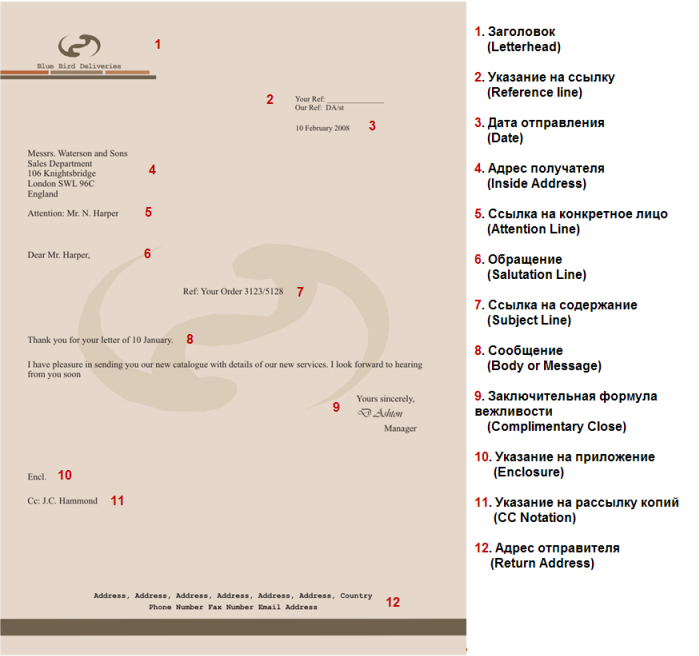
- •Unit 1 Structure and Presentation
- •1.Letterhead
- •2. Reference line
- •3. Date
- •4. Inside address
- •Attention Line
- •6. Salutation line
- •Subject line / title.
- •8. Body or Message
- •Complimentary
- •10. Enclosure
- •11.Carbon Copy
- •Practice
- •Informative Letters
- •2A. Covering letters Study section
- •Practice
- •2B. Acknowledgements Study Section
- •Practice
- •2C. Notifications, Announcements and
- •Introductions Study Section
- •Unit 3 Letters that ask Study section
- •3A. Requests
- •3B. Enquiries and Orders
- •Enquiry
- •Orders Study section
- •General conditions of the order
- •Terms of payment
- •Delivery Date
- •Practice
- •Letter Writing Practice
- •Applying for a job Study section
- •1.Being turned down/ turning down an applicant
- •2.Being offered/ offering a post
- •3.Details of employment
- •4. Accepting a post
- •Sample of Resume
- •Sample of Cover Letter
- •Employment
- •Linguistic Background of Business Correspondence
- •I: closing the letter
МИНИСТЕРСТВО ОБРАЗОВАНИЯ РЕСПУБЛИКИ БЕЛАРУСЬ
УО «Белорусский государственный экономический университет»
Т.К. Кирильчик, О.И. Махонина
BUSINESS CORRESPONDENCE
ДЕЛОВАЯ КОРРЕСПОНДЕКЦИЯ
Электронное учебно-методическое пособие по дисциплине «Иностранный язык (английский)»
Минск 2011
Рецензент: старший преподаватель кафедры теории и практики английской речи БГЭУ Левченко Л.П.
Рекомендовано кафедрой теории и практики английской речи БГЭУ
Кирильчик Т.К., Махонина О.И.
Business Correspondence = Деловая корреспонденция: электронное учеб.-метод. пособие / Т.К. Кирильчик, О.И. Махонина – Минск: БГЭУ, 2011. – 77 c.
Учебно-методическое пособие предназначено для студентов, изучающих курс делового английского языка. В пособии представлены методические указания, языковые и речевые упражнения для развития и формирования умений и навыков написания деловых писем. Предназначено для студентов БГЭУ дневной формы обучения.
Unit 1 Structure and Presentation
The aim in business writing is to communicate as clearly and concisely as you can. In our high-tech culture we expect many tasks to take far less time than they do. Writing is one of them. The ability to write well – clearly and concisely – it is an essential skill. Contrary to general belief, writing is not something only ‘writers’ do; it is a basic skill for getting through life. However, writing is a high-level conceptual skill and it does take time. Many mental activities are taking place while you are writing: analyzing the audience, remembering and deciding on what information to present, organizing the information, putting it into comprehensible sentences, paying attention to the rules of good writing, proofreading, etc.
When getting started, remember, if you gain control of yourself, you will gain control of your topic.
First of all you ask yourself the question about the purpose of your writing:
Are you writing to inquire, inform, persuade, motivate, or do you have more than one purpose?
Second, get interested in its scope:
Given your needs and your reader’s needs, how much information should you include?
Third, see clearly the contents of your writing:
What kind of information will help you to achieve your purpose? Do you have all information you need? How, or where, can you get additional information?
At last, you should ask yourself about the available constraints:
What makes your task more difficult? Time or cost constraints? Your reader’s attitudes? Your own lack of credibility?
Put yourself in your reader’s place and look at the message through his eyes. Most of the readers want the results of your thinking, not the thinking itself. Remember that there is a difference between thinking and communicating. When experimenting with various ways to organize the information be guided by two factors: (1) your reader’s knowledge and interest and (2) your purpose and the information itself. The contents of any letter may be summarized as follows: (1) opening, (2) purpose; (3) action, and (4) polite expressions.
Task 1
1.What should you take into consideration while you are writing?
2.What can be the purposes of your writing?
3.What should you keep in mind while writing?
4.Why are reader’s more interested in the results of the writer’s thinking?
5.Can you write well?
6.How important for you is the ability to write well?
7.What is the most important to organize information properly?
There are many ways to lay out a business letter. This letter is an example of a modern way, called ``block style``. Notice:
The name and address of the addressee are at the top on the left (the addressee is the person you are writing to).
The date is on the right
There is no punctuation in the address or after `yours faithfully/sincerely` or Dear…
The paragraphs start at the margin and there are line spaces between them
The writer`s name and title are under the signature

